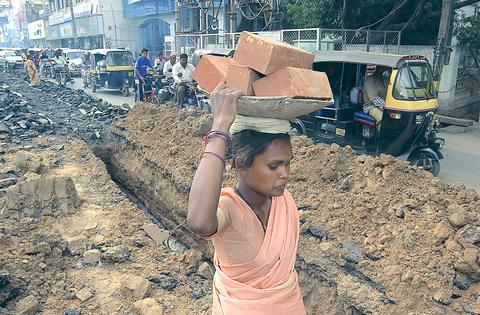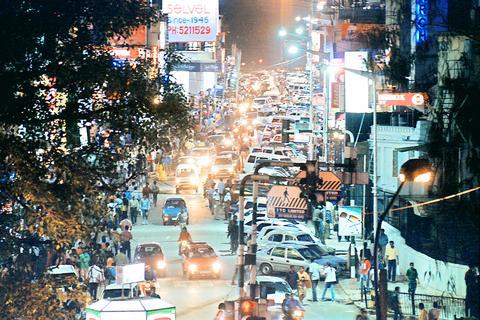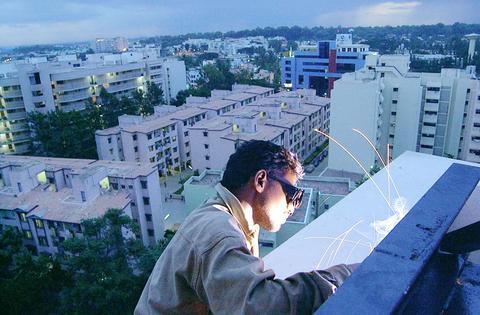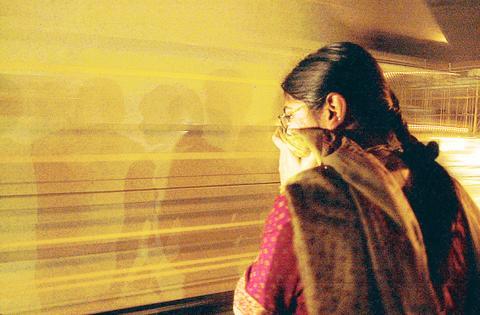From Bill Gates to Tony Blair, most of India's celebrity visitors make a stop at the country's high-technology crown, the once-sleepy garden city of Bangalore.
During those visits, the government of southern Karnataka state regulates traffic and keeps the power running in its capital city. Bangalore runs smoothly enough to win more investment and jobs.

PHOTO: AP
But when the guests are gone, Bangalore's highly skilled workers navigate potholed roads and idle through hours of traffic to reach homes that lack enough water to cook and bathe. When power goes out, evenings pass with no computers or even fans to drive off mosquitoes.

``A lot of [technological] investment has taken place in the recent years, but quality of life has not improved,'' said Vinay Baindur, who coordinates Civic, an advocacy group for better roads, water and power. ``Authorities don't seem to have the capacity to plan and manage this growth.''
For a software industry that has brought US$2 billion a year in revenue to the city of 5.5 million people, poor roads mean delays and lost productivity. Technologists see their earning potential vanish in the traffic.

Though most companies have their own generators to keep operating during power outages, buying and fueling them eat into profits.

One company, Wipro, has given up on expanding its outsourcing businesses in Bangalore.
``It is embarrassing when there are four power cuts during one hour of discussion with clients,'' said Azim Premji, Wipro's head and India's richest man.
Premji even threatened a sit-in -- a time-tested political tactic in India -- to force the state government to improve infrastructure.
The response: a task force to study infrastructure needs around Wipro's offices, which visitors reach by navigating more than one kilometer of a narrow, potholed road.
Government officials insist Bangalore is not losing business.
``You have pockets of excellence where infrastructure is very good,'' said Vivek Kulkarni, the senior bureaucrat in Karnataka's Information Technology Department. ``When prosperity increases, these facilities will expand.''
As for electricity reliability, Kulkarni said: ``Power problems affect the common people. Technology companies make their own arrangements, so their business is not affected.''
When infrastructure came up at a recent meeting, Karnataka's top elected official, Chief Minister Krishna, said, ``I am not going to be apologetic.''
But the top federal appointee in the government, Governor T. N. Chaturvedi, responded at the meeting by asking Krishna to take the complaints seriously.
Studies seem to be the state government's standard reaction to complaints.
The government announced in 1992 that it would build an international airport in Bangalore. Currently, 25 international flights a week fly through a cramped domestic terminal.
``The government has planned for several years, but not even broken ground on the project,'' said Kiran Karnik, president of India's National Association of Software and Service Companies. Infrastructure projects are talked about, but ``they take forever'' to get started.
Business leaders want a bigger airport to permit more international flights. So far, only Air India operates direct flights to the US -- a handicap for a city that earns two-thirds of its software income from the US and houses Microsoft, Oracle, Intel and Yahoo.
``The lack of sufficient direct flights into Bangalore causes many business travelers to avoid Bangalore,'' said Anees Ahmed, head of Mistral Software, a Bangalore-based company.
Some officials blame infrastructure problems on a rapid population increase that came with the booming job market. Bangalore's population grew 42 percent between 1981 and 2001.
Without a functioning public transportation system, Bangalore's citizens rely on motor scooters and unbalanced, three-wheeled motorized rickshaws. They are also buying more cars, adding to the 1.8 million vehicles that already jam roads.
Baindur, of the Civic group, said the city's newly built highway bridges and circular roads -- meant to bypass traffic congestion points -- were badly planned and ended up creating jams at crossroads. Wider routes lead to narrow ones, where traffic gets choked.
Meanwhile, digging by telephone companies and battering by rains create potholes that don't get patched. Widening roads and creating additional parking spaces narrow sidewalks, where overflowing garbage cans and drainage pipes already reduce space for pedestrians.
Despite the city's high-tech reputation, technological infrastructure can also be lacking.
Visitors to conventions and exhibitions find breakdowns in Internet service, scarcity of telephones and power outages at the media centers.
At the national air show this February -- held at Bangalore's small airport -- 300 journalists were accredited, but officials provided only four computers. On the day French Prime Minister Jean-Pierre Raffarin was the chief guest, Internet facilities at the media center failed.
With a population of 53 million, Karnataka state has only about 6,000 megawatts of power generation capacity, or 1,200 megawatts less than what it needs. Karnataka depends on hydroelectric power stations, which don't have enough water in the summer.
California has 10 times the electric capacity for its 35 million people, leading to questions about whether Bangalore can justify its claims to be the ``Silicon Valley of India.''
``From the infrastructure viewpoint,'' Baindur said, ``you can't.''
On the Net:
Bangalore's IT department: http://www.bangaloreit.com

May 26 to June 1 When the Qing Dynasty first took control over many parts of Taiwan in 1684, it roughly continued the Kingdom of Tungning’s administrative borders (see below), setting up one prefecture and three counties. The actual area of control covered today’s Chiayi, Tainan and Kaohsiung. The administrative center was in Taiwan Prefecture, in today’s Tainan. But as Han settlement expanded and due to rebellions and other international incidents, the administrative units became more complex. By the time Taiwan became a province of the Qing in 1887, there were three prefectures, eleven counties, three subprefectures and one directly-administered prefecture, with

It’s an enormous dome of colorful glass, something between the Sistine Chapel and a Marc Chagall fresco. And yet, it’s just a subway station. Formosa Boulevard is the heart of Kaohsiung’s mass transit system. In metro terms, it’s modest: the only transfer station in a network with just two lines. But it’s a landmark nonetheless: a civic space that serves as much more than a point of transit. On a hot Sunday, the corridors and vast halls are filled with a market selling everything from second-hand clothes to toys and house decorations. It’s just one of the many events the station hosts,

Two moves show Taichung Mayor Lu Shiow-yen (盧秀燕) is gunning for Chinese Nationalist Party (KMT) party chair and the 2028 presidential election. Technically, these are not yet “officially” official, but by the rules of Taiwan politics, she is now on the dance floor. Earlier this month Lu confirmed in an interview in Japan’s Nikkei that she was considering running for KMT chair. This is not new news, but according to reports from her camp she previously was still considering the case for and against running. By choosing a respected, international news outlet, she declared it to the world. While the outside world

Through art and storytelling, La Benida Hui empowers children to become environmental heroes, using everything from SpongeBob to microorganisms to reimagine their relationship with nature. “I tell the students that they have superpowers. It needs to be emphasized that their choices can make a difference,” says Hui, an environmental artist and education specialist. For her second year as Badou Elementary’s artist in residence, Hui leads creative lessons on environmental protection, where students reflect on their relationship with nature and transform beach waste into artworks. Standing in lush green hills overlooking the ocean with land extending into the intertidal zone, the school in Keelung